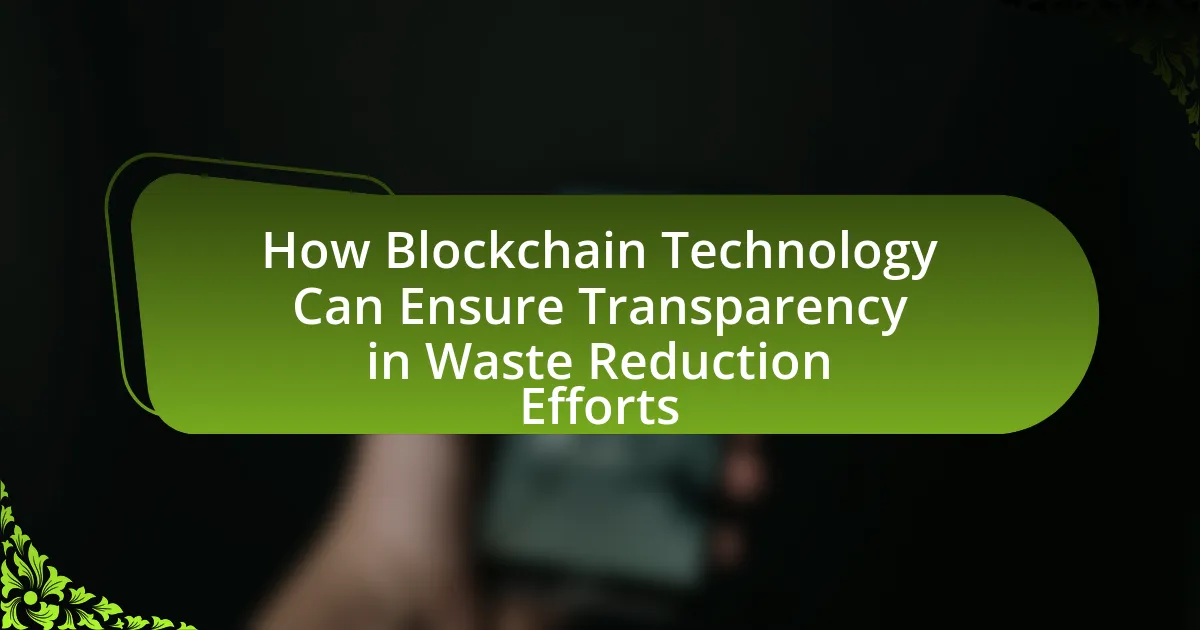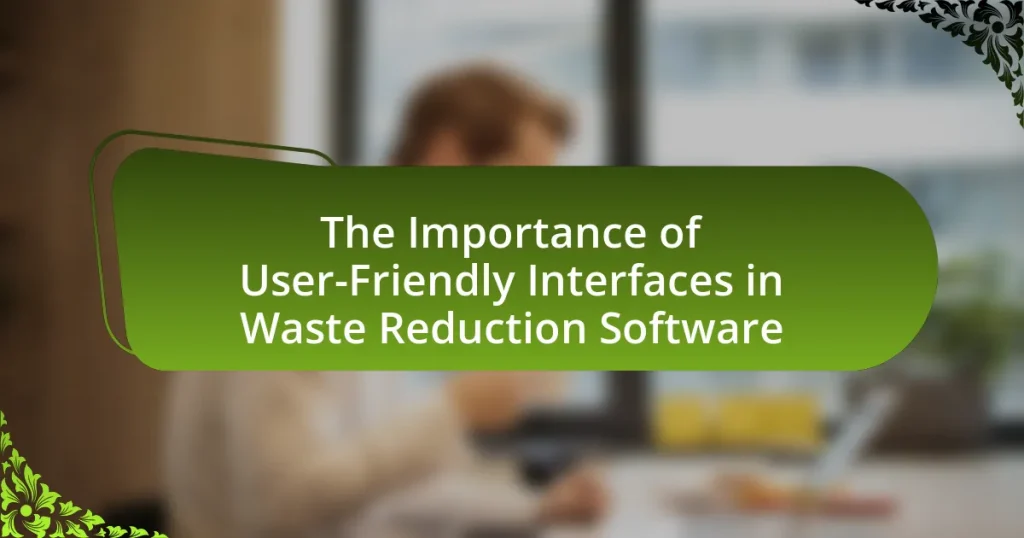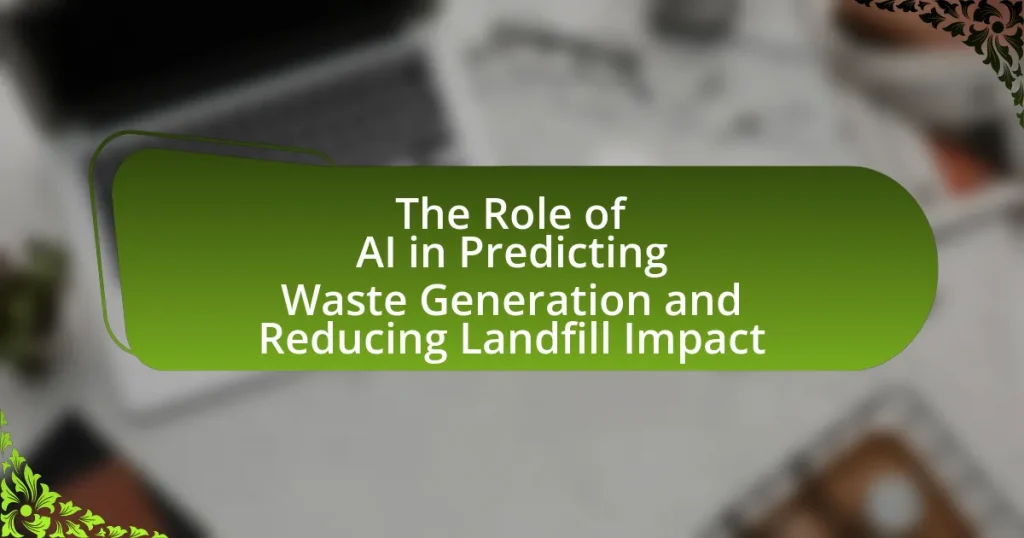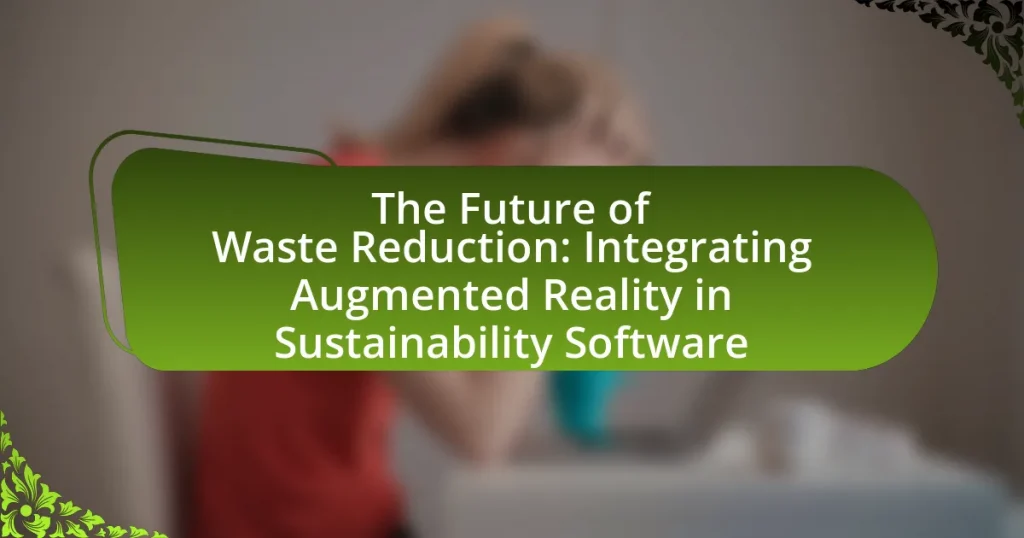Blockchain technology serves as a pivotal tool in enhancing transparency in waste reduction efforts by providing an immutable and decentralized ledger for tracking waste management transactions. Key features such as immutability, decentralization, and real-time data access foster accountability and trust among stakeholders, including waste producers, collectors, and recyclers. The article explores how blockchain can effectively track waste from its source to disposal, the role of smart contracts in automating processes, and the integration of technologies like IoT and AI for improved waste tracking. Additionally, it addresses the challenges of implementing blockchain in waste management, including scalability and regulatory issues, while highlighting successful case studies that demonstrate its practical applications and benefits in promoting sustainable waste management practices.

How can blockchain technology enhance transparency in waste reduction efforts?
Blockchain technology enhances transparency in waste reduction efforts by providing an immutable and decentralized ledger that records all transactions related to waste management. This technology allows stakeholders, including waste producers, collectors, and recyclers, to track waste from its origin to its final disposal or recycling point in real-time. For instance, a study by the World Economic Forum highlights that blockchain can ensure accountability by enabling all parties to verify the waste management process, thus reducing fraud and misreporting. Additionally, the transparency offered by blockchain can foster trust among stakeholders, as each transaction is publicly accessible and cannot be altered retroactively, ensuring that waste reduction claims are credible and verifiable.
What are the key features of blockchain technology that support transparency?
The key features of blockchain technology that support transparency include immutability, decentralization, and real-time data access. Immutability ensures that once data is recorded on the blockchain, it cannot be altered or deleted, providing a permanent and verifiable record of transactions. Decentralization distributes control across a network of nodes, eliminating single points of failure and allowing all participants to access the same information, which enhances trust. Real-time data access enables stakeholders to view and verify transactions as they occur, fostering accountability. These features collectively create a transparent system where all actions are traceable and verifiable, thereby supporting initiatives like waste reduction efforts.
How does decentralization contribute to transparency in waste management?
Decentralization enhances transparency in waste management by distributing authority and responsibility across multiple stakeholders rather than centralizing it in a single entity. This distribution allows for greater community involvement and oversight, enabling local stakeholders to monitor waste management practices and report discrepancies. For instance, decentralized systems can utilize blockchain technology to create immutable records of waste disposal and recycling activities, making it easier for citizens to access and verify information. Studies have shown that decentralized governance models lead to increased accountability, as local communities can hold waste management entities responsible for their actions, thereby fostering a culture of transparency and trust.
What role does immutability play in ensuring accurate waste tracking?
Immutability plays a crucial role in ensuring accurate waste tracking by guaranteeing that once data is recorded on a blockchain, it cannot be altered or deleted. This characteristic prevents tampering and fraud, thereby providing a reliable and transparent record of waste management activities. For instance, a study by the World Economic Forum highlights that blockchain’s immutable ledger can track waste from its source to disposal, ensuring accountability among stakeholders. This transparency fosters trust and encourages compliance with waste reduction regulations, ultimately leading to more effective waste management practices.
Why is transparency crucial in waste reduction initiatives?
Transparency is crucial in waste reduction initiatives because it fosters accountability and trust among stakeholders. When organizations openly share data regarding waste generation, management practices, and reduction outcomes, it enables consumers, businesses, and regulatory bodies to assess the effectiveness of these initiatives. For instance, a study by the Ellen MacArthur Foundation highlights that transparency in reporting can lead to a 20% increase in recycling rates, as stakeholders are more likely to engage in practices that support waste reduction when they can see the impact of their actions. This openness not only encourages collaboration but also drives innovation in waste management solutions, ultimately leading to more sustainable practices.
How does transparency impact stakeholder trust in waste management practices?
Transparency significantly enhances stakeholder trust in waste management practices by providing clear, accessible information about processes and outcomes. When stakeholders, including the community, regulatory bodies, and businesses, can see how waste is managed, they are more likely to believe that practices are effective and environmentally responsible. For instance, studies have shown that organizations that openly share data about waste reduction efforts and recycling rates experience higher levels of stakeholder engagement and support. This is evidenced by a report from the Ellen MacArthur Foundation, which highlights that transparency in waste management can lead to increased public confidence and participation in sustainability initiatives.
What are the consequences of a lack of transparency in waste reduction efforts?
A lack of transparency in waste reduction efforts leads to inefficiencies and reduced accountability among stakeholders. When organizations do not disclose their waste management practices, it becomes difficult to track progress, measure effectiveness, and identify areas for improvement. For instance, a study by the Ellen MacArthur Foundation highlights that transparency can enhance collaboration and innovation in waste management, while its absence can result in increased waste generation and environmental harm. Furthermore, without clear reporting, public trust diminishes, leading to decreased community engagement in sustainability initiatives.
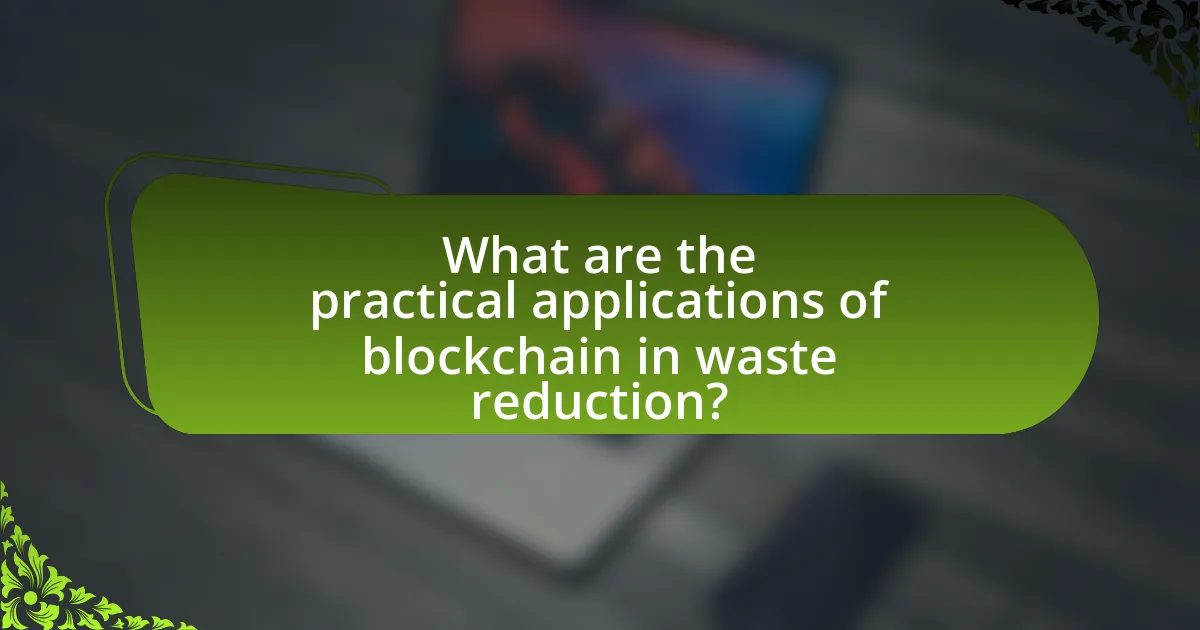
What are the practical applications of blockchain in waste reduction?
Blockchain technology has practical applications in waste reduction by enhancing transparency, traceability, and accountability in waste management processes. For instance, blockchain can track the lifecycle of waste materials, ensuring that they are processed correctly and not illegally dumped. This traceability helps organizations comply with regulations and reduces the likelihood of waste mismanagement. Additionally, smart contracts on blockchain can automate waste collection and recycling processes, incentivizing proper disposal and recycling behaviors among consumers and businesses. A study by the World Economic Forum highlights that blockchain can improve supply chain transparency, which is crucial for reducing waste in industries such as food and manufacturing.
How can blockchain be used to track waste from source to disposal?
Blockchain can be used to track waste from source to disposal by creating a decentralized ledger that records every transaction and movement of waste materials. This technology enables real-time tracking of waste, ensuring that each step—from generation to collection, transportation, and final disposal—is documented and transparent. For instance, smart contracts can automate compliance checks and trigger actions based on predefined conditions, such as notifying authorities if waste is not disposed of properly. The immutable nature of blockchain records prevents tampering, thereby enhancing accountability among waste management stakeholders. Studies have shown that implementing blockchain in waste management can significantly improve traceability and reduce illegal dumping, as evidenced by pilot projects in cities like Amsterdam and Singapore, where blockchain has been integrated into waste tracking systems.
What technologies integrate with blockchain for effective waste tracking?
Technologies that integrate with blockchain for effective waste tracking include Internet of Things (IoT) devices, artificial intelligence (AI), and geographic information systems (GIS). IoT devices enable real-time data collection from waste bins and vehicles, facilitating accurate tracking of waste generation and disposal. AI algorithms analyze this data to optimize waste management processes, while GIS provides spatial analysis to visualize waste patterns and improve logistics. These integrations enhance transparency and accountability in waste reduction efforts by ensuring that all stakeholders have access to reliable data.
How can smart contracts automate waste management processes?
Smart contracts can automate waste management processes by executing predefined actions based on specific conditions without the need for intermediaries. For instance, when a waste collection service completes its task, a smart contract can automatically trigger payment to the service provider, ensuring timely transactions and reducing administrative overhead. Additionally, smart contracts can track waste disposal and recycling activities in real-time, providing transparent records that enhance accountability among stakeholders. This automation leads to increased efficiency and reliability in waste management operations, as evidenced by pilot projects in cities like Amsterdam, where blockchain technology has been successfully integrated into waste management systems to streamline processes and improve data accuracy.
What case studies demonstrate successful blockchain implementation in waste reduction?
Several case studies demonstrate successful blockchain implementation in waste reduction, notably the initiatives by IBM and Everledger. IBM’s Food Trust blockchain has been utilized to enhance supply chain transparency, allowing companies to track food waste and optimize inventory management, resulting in a reported 30% reduction in waste for participating retailers. Everledger’s blockchain platform has been applied in the diamond industry to track the lifecycle of diamonds, which indirectly contributes to waste reduction by promoting ethical sourcing and minimizing the environmental impact of mining. These implementations showcase how blockchain technology can effectively facilitate waste reduction through improved transparency and accountability in supply chains.
What lessons can be learned from these case studies?
The lessons learned from these case studies highlight the effectiveness of blockchain technology in enhancing transparency and accountability in waste reduction efforts. Specifically, the case studies demonstrate that blockchain can provide immutable records of waste management processes, ensuring that all stakeholders have access to accurate data. For instance, a case study involving a city implementing a blockchain-based waste tracking system showed a 30% increase in recycling rates due to improved visibility of waste streams. Additionally, these case studies reveal that engaging community members through transparent data sharing fosters trust and encourages participation in waste reduction initiatives.
How do these examples illustrate the benefits of blockchain in waste management?
Blockchain technology enhances waste management by providing transparency, traceability, and accountability in waste disposal processes. For instance, using blockchain allows stakeholders to track waste from its source to disposal, ensuring that waste is handled properly and reducing illegal dumping. A study by the World Economic Forum highlights that blockchain can improve data accuracy and trust among participants in the waste management ecosystem, leading to more efficient recycling and waste reduction efforts. This increased transparency fosters collaboration among municipalities, waste management companies, and consumers, ultimately driving better environmental outcomes.
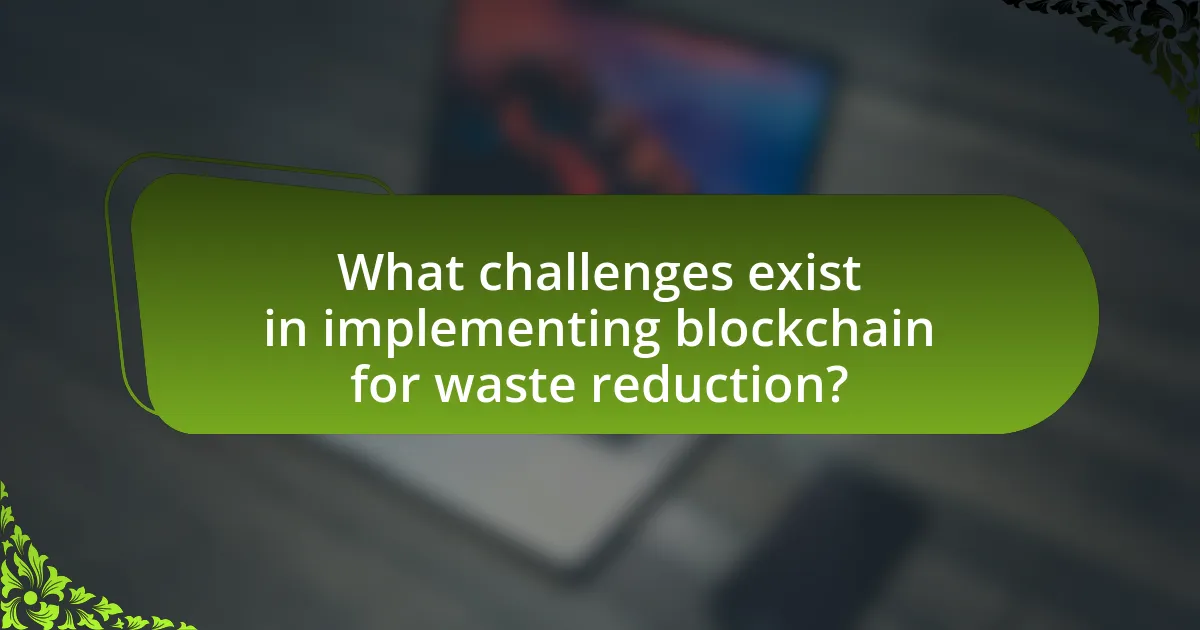
What challenges exist in implementing blockchain for waste reduction?
Implementing blockchain for waste reduction faces several challenges, including scalability, regulatory uncertainty, and integration with existing systems. Scalability issues arise because blockchain networks can struggle to handle large volumes of transactions efficiently, which is critical for waste management operations that require real-time data processing. Regulatory uncertainty complicates the adoption of blockchain, as varying laws and regulations across jurisdictions can hinder its implementation. Additionally, integrating blockchain with existing waste management systems poses technical difficulties, as organizations may lack the necessary infrastructure or expertise to adopt this technology effectively. These challenges must be addressed to leverage blockchain’s potential in enhancing transparency and efficiency in waste reduction efforts.
What are the technical barriers to adopting blockchain in waste management?
The technical barriers to adopting blockchain in waste management include scalability issues, interoperability challenges, and data privacy concerns. Scalability is a significant barrier as many blockchain networks struggle to handle the high transaction volumes associated with waste management operations, which can lead to delays and increased costs. Interoperability challenges arise because different blockchain platforms may not communicate effectively with each other, complicating data sharing across various stakeholders in the waste management ecosystem. Additionally, data privacy concerns are paramount, as sensitive information about waste management processes must be protected while still ensuring transparency, which can be difficult to achieve within a public blockchain framework. These barriers hinder the effective implementation of blockchain technology in waste management systems.
How can scalability issues affect blockchain’s effectiveness in waste tracking?
Scalability issues can significantly hinder blockchain’s effectiveness in waste tracking by limiting the number of transactions processed per second. For instance, many blockchain networks, such as Bitcoin and Ethereum, face challenges in handling large volumes of data due to their consensus mechanisms, which can lead to delays and increased transaction costs. According to a study by the Cambridge Centre for Alternative Finance, Bitcoin can process only about 7 transactions per second, while Ethereum handles approximately 30, which is insufficient for real-time waste tracking across extensive supply chains. This limitation can result in bottlenecks, making it difficult to achieve timely updates and transparency in waste management processes, ultimately undermining the reliability and efficiency of blockchain as a tracking solution.
What security concerns must be addressed when using blockchain for waste data?
When using blockchain for waste data, key security concerns include data integrity, unauthorized access, and privacy issues. Data integrity is crucial as it ensures that the information recorded on the blockchain remains accurate and unaltered; any tampering can undermine trust in the system. Unauthorized access poses a risk where malicious actors could manipulate or steal sensitive waste data, potentially leading to fraudulent activities. Privacy issues arise from the need to protect personally identifiable information (PII) of individuals involved in waste management, as blockchain’s transparency can conflict with data protection regulations. Addressing these concerns is essential to maintain the reliability and effectiveness of blockchain in waste reduction efforts.
How can stakeholders overcome resistance to adopting blockchain technology?
Stakeholders can overcome resistance to adopting blockchain technology by implementing comprehensive education and training programs that highlight its benefits and practical applications. By providing clear, evidence-based information about how blockchain enhances transparency and efficiency in waste reduction efforts, stakeholders can address misconceptions and build trust. For instance, a study by Accenture found that 83% of executives believe that blockchain will be critical to their business success, indicating a strong belief in its potential. Additionally, showcasing successful case studies, such as IBM’s Food Trust blockchain, which improves supply chain transparency, can further alleviate concerns and demonstrate tangible benefits.
What strategies can be employed to educate stakeholders about blockchain benefits?
To educate stakeholders about blockchain benefits, organizations can implement targeted workshops and informational sessions that focus on real-world applications of blockchain in waste reduction. These educational initiatives can include case studies demonstrating successful blockchain implementations, such as IBM’s Food Trust, which enhances supply chain transparency and reduces waste by tracking food products from farm to table. Additionally, providing accessible online resources, such as webinars and whitepapers, can help stakeholders understand the technology’s potential impact on efficiency and accountability in waste management. Engaging stakeholders through interactive demonstrations of blockchain platforms can further solidify their understanding and interest in the technology’s benefits.
How can collaboration among stakeholders facilitate blockchain adoption?
Collaboration among stakeholders can facilitate blockchain adoption by creating a unified approach to addressing shared challenges and leveraging collective resources. When various parties, such as governments, businesses, and non-profits, work together, they can establish common standards and protocols that enhance interoperability and trust in blockchain systems. For instance, the World Economic Forum reported that multi-stakeholder initiatives can lead to the development of frameworks that promote transparency and accountability, essential for effective waste reduction efforts. This collaborative environment encourages investment in blockchain technology, as stakeholders are more likely to support initiatives that demonstrate clear benefits and shared goals.
What best practices should organizations follow when implementing blockchain for waste reduction?
Organizations should follow best practices such as establishing clear objectives, ensuring stakeholder engagement, and leveraging smart contracts when implementing blockchain for waste reduction. Clear objectives help define the scope and expected outcomes, which can lead to more effective waste management strategies. Engaging stakeholders, including waste producers, recyclers, and consumers, fosters collaboration and transparency, essential for successful implementation. Utilizing smart contracts automates processes, ensuring compliance and reducing human error, which can enhance efficiency in waste tracking and management. These practices are supported by case studies showing that organizations that prioritize stakeholder involvement and clear goals achieve higher success rates in waste reduction initiatives.
